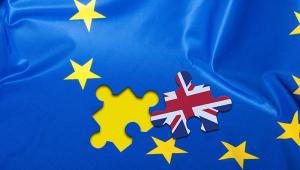Gary Gillespie said that under a “worst case” scenario after Brexit, which would see the UK trade under World Trade Organization rules, Scottish GDP would be 8.6% lower by 2030 than it would have been had the UK remained within the EU.
Almost half of Scotland’s trade – just over £12bn – is currently with the EU.
However, analysis of the projected drop in GDP showed that while the impact on trade would fade over time, the consequences on Scotland’s population and productivity would be far greater and longer lasting.
“Migration is really important and so is productivity,” Gillespie told an audience of economic development professionals in Edinburgh on 15 March.
“Trade is less so, because … if the market to the EU was less attractive, [companies] would adjust, and other sectors would have opportunities.”
Unlike other parts of the UK, Scotland was entirely dependent on inward migration for its population growth over the next 25 years, he said, with workers from other countries critical for some sectors of the economy and the sustainability of communities.
Scotland would also lose productivity gains arising from integrated supply chains and economies of scale across the EU.
However, that did not mean the economy was going to contract after Brexit, but that current growth of 2% a year would fall to around 1.8%.
“The economy continues to grow, but it’s not growing at previous trend rates,”
Gillespie said. “There’s already evidence of that in terms of the UK if you look at the Spring Statement.”
He said the consequences of the new arrangements would vary between sectors and regions of the UK, so some areas would be disproportionately hit. “The closer you get to the status quo, the less distributional impact you have,” he said.
The Scottish Government’s preferred position was a Norway-type arrangement which would see the UK retain access to the single market as part of the European Economic Area.
Describing the “variable geometry” under which a complex web of arrangements on trade, immigration and currency exist across Europe, Gillespie said there was scope for a creative solution.
“The EU has always known member states have different desires for different levels of integration, so there potentially could be associate membership or some other way to mitigate some of the impact,” he said.
Whatever the outcome, a well-managed transition plan was essential to avoid a crisis of confidence and the triggering of shock throughout the economy, as was seen in the financial crisis.
“Longer transition arrangements [would] allow both the UK and businesses to adjust to the new reality,” he said.
At the event, organised by the Economic Development Association Scotland, Ian Wattie, managing partner at law firm Burness Paull, told delegates that the UK’s right to trade seamlessly would diminish, and its lack of preparedness for a hard
Brexit in terms of physical and IT infrastructure was “sobering”.
He expected to see “a relaxed approach” towards EU nationals coming to the UK.
“Frankly, the UK government doesn’t have the infrastructure and people to cope with US-type border checks [so] there will always be an outsourcing of border control to employers,” he said.
Some of his clients saw an opportunity in Brexit to make public procurement cheaper, simpler and more accessible, he said.
However, others worried about future investment in economic development in a less certain climate, as well as the impact on urban renewal funding, particularly on social housing.











